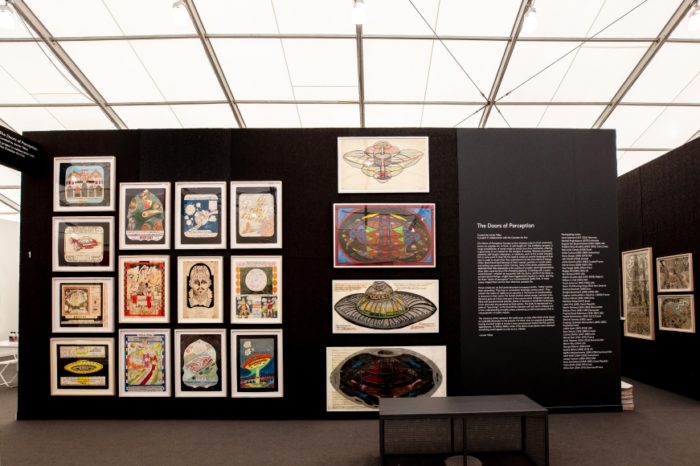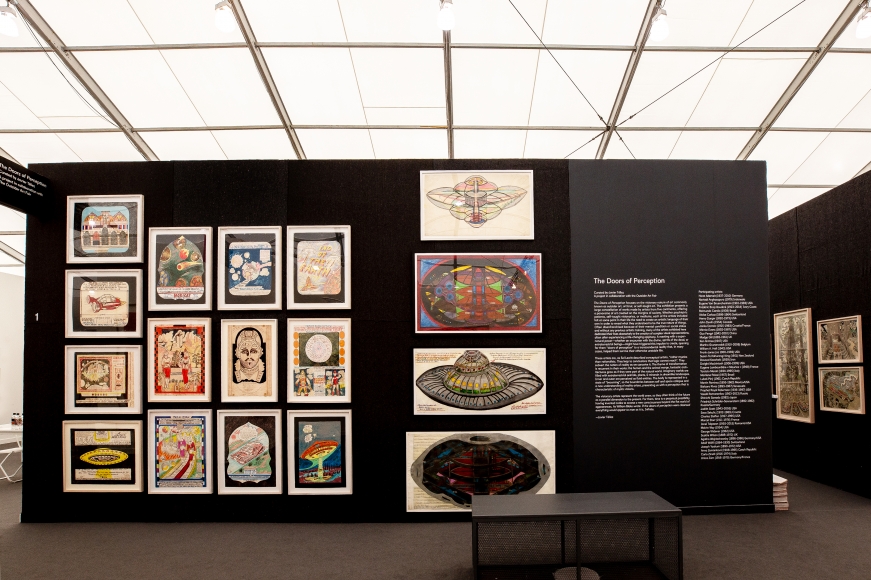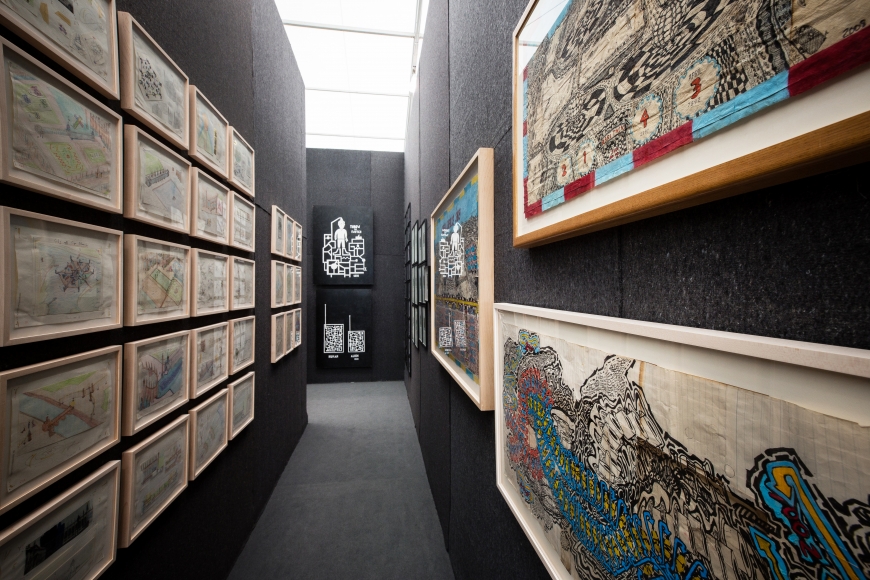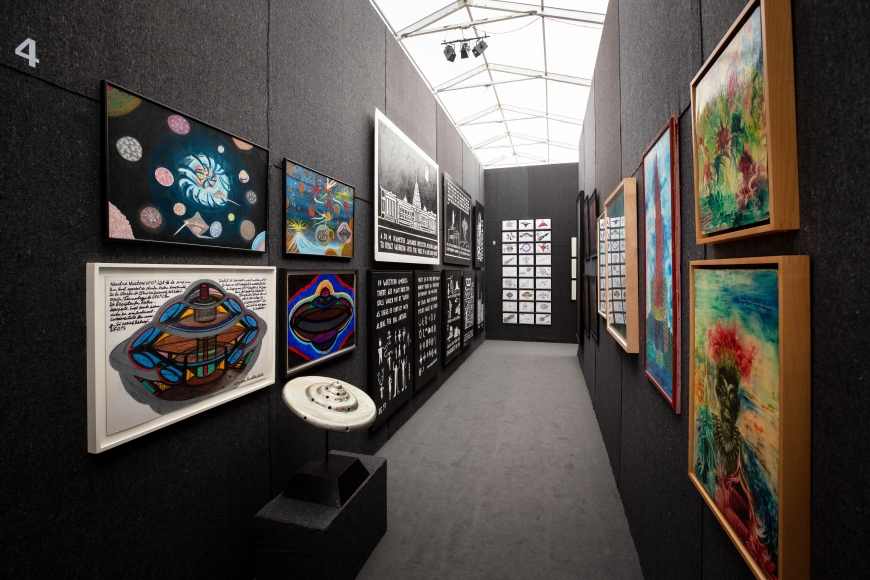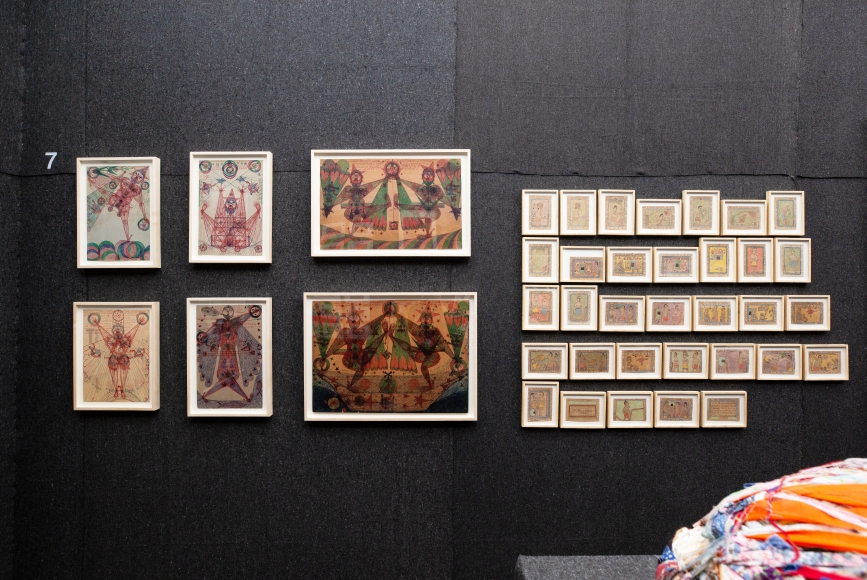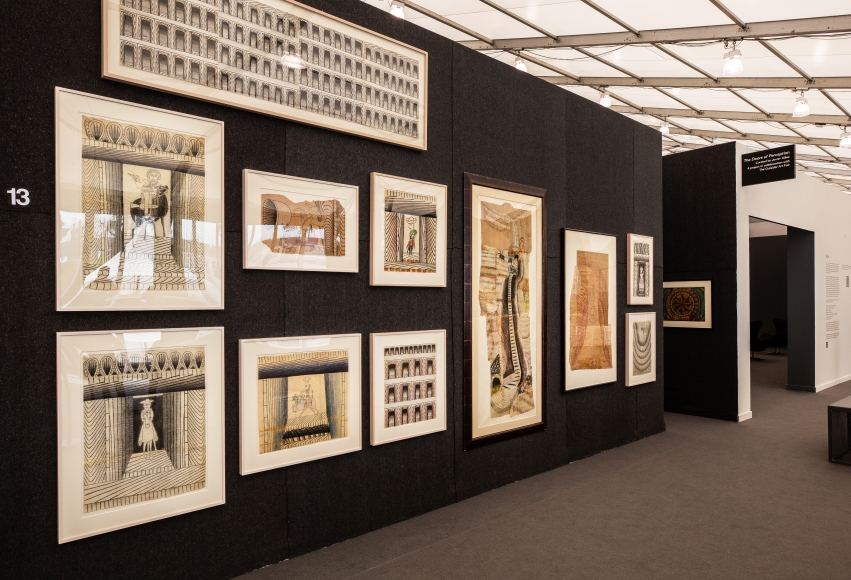Dates / Fechas:
May 2 – 5, 2019
Place / Lugar:
Frieze Art Fair
Randall’s Island Park,
New York, NY
Collaboration Role / Rol de colaboración:
Assistant Curator of
Javier Téllez
More info – Más información:
The Outsider Artfair
Frieze New York
The Doors Of Perception, was a unique project by The Outsider Art Fair in collaboration with Frieze New York curated by the artist Javier Téllez.
The Doors of Perception focuses on the visionary nature of art commonly known as outsider art, art brut, or self-taught art. The exhibition presents a large constellation of works made by exceptionally gifted artists from five continents, offering a panorama of art created on the margins of society. Whether psychiatric patients, self-taught visionaries, or mediums, each of the artists in the exhibition felt at some point in their life the need to create an artistic language of their own in order to reveal what they understood to be the true nature of things. Often disenfranchised because of their mental condition or social status and without any previous artistic training, many of the artists exhibited here dedicated their lives obsessively to the creation of complex visual representations, often after experiencing a life-changing epiphany. A meeting with a supernatural power—whether an encounter with the divine, spirits of the dead, or extraterrestrial beings—might have triggered this impulse to create. These remarkable events produced strong centrifugal forces that drove the artists from chaos to order, opening for them “doors of perception” to a transcendental reality that, in many cases, helped them survive their otherwise unstable life.
The artists included in the exhibition are, as Sol Lewitt described conceptual artists, “rather mystics than rationalists. They leap to conclusions that logic cannot reach.” Their many artistic languages not only question our beliefs about madness and normalcy, but also subvert the notion of reality as we conceive it. The theme of transformation is recurrent in their works: the body is perceived as a multiple entity (Domsic, Fengyi, Charles Steffen, Carlo Zinelli, Zürn), the human and the animal merge (Angkasapura, Friedrich Schröder-Sonnenstern, Shinichi Sawada, Sava Sekulić), fantastic architectures grow as if they were part of the natural world (Eugene Von Bruenchenhein, William Hall, Marcel Storr), imaginary worlds are filled with extraterrestrial animal, plants, and minerals in dreamlike landscapes (Darger, Joseph Yoakum, Zemánková). Notions of inside and outside permeate so inner and outer are perceived as fluid entities with internal organs and bones made visible in portraits of the body (Angkasapura, Fengyi, Luboš Plný). Everything is represented in a state of “becoming,” so the boundaries between self and space collapse and a new understanding of reality arises, presenting us with a perception that is characteristic of mystic visions.
Truly utopian, the visionary artists represent the world anew, so they often think of the future as a parallel dimension to the present (Hall, Prophet Royal Robertson, Widener, Wölfli). For them, time is a perpetual possibility, having invented codes to access a new consciousness beyond the flat world of appearances (John Devlin, Ionel Talpazan, Way, Widener). As William Blake wrote: “If the doors of perception were cleansed everything would appear to man as it is, Infinite.”
– Javier Téllez, for The Outsider Art Fair and Frieze New York.
ABOUT JAVIER TELLEZ
For the past twenty years, artist Javier Téllez (b. 1969, Valencia, Venezuela) has been making films in collaboration with people living with mental illness. Both of Téllez’s parents were psychiatrists, so he grew up in contact with people affected by mental illness; it was natural that it would become the main subject of his work.
Throughout his career, Téllez has been interested in outsider art /art brut/ self-taught art and has been studying the subject for many years. Previously, he curated an exhibition at the Prinzhorn Collection (Heidelberg) that focused on the works of mentally ill artists that were loaned by the University of Heidelberg to the infamous exhibition Entartete Kunst (Munich, 1937). In his own work, Téllez reflects a sustained interest in bringing peripheral communities and invisible situations to the fore of contemporary art, addressing institutional dynamics, disability, and mental illness as marginalizing conditions. Téllez’s projects have often involved working in collaboration with people diagnosed with mental illness to produce film installations that question the notions of the normal and the pathological.
Téllez’s art has been the subject of many solo exhibitions at numerous venues including the Memorial Art Gallery, University of Rochester (2018); the San Francisco Art Institute (2014); Kunsthaus Zürich (2014); Stedelijk Museum voor Actuele Kunst, Ghent (2013); the Museum of Contemporary Art, Cleveland (2011); and the Bronx Museum of the Arts, New York (2005). His work has been exhibited at documenta, Kassel (2012); Manifesta7, Trentino-South Tyrol, Italy (2008); Biennale of Sydney (2008); Whitney Biennial, New York (2008); Venice Biennale (2001, 2003); and the Yokohama Triennial (2001). Téllez’s work is part of many public collections including those of Tate Modern, London; The Museum of Modern Art, New York; Solomon R. Guggenheim Museum, New York; Museum of Fine Arts, Houston; Kunsthaus, Zürich; National Galerie, Berlin; and the Museo Nacional Centro de Arte Reina Sofía, Madrid. He received a Guggenheim Fellowship in 1999 and the Global Mental Health Award for Innovation in the Arts from Columbia University in 2016. Javier Téllez has lived and worked in New York since 1993.
The Doors Of Perception, fue un proyecto especial de The Outsider Art Fair en colaboración con Frieze New York, comisariado por el artista Javier Téllez.
The Doors of Perception se centra en la naturaleza visionaria del arte comúnmente conocido como arte outsider, art brut, o arte autodidacta. La exposición presenta una gran constelación de obras realizadas por artistas excepcionalmente dotados de los cinco continentes, ofreciendo un panorama del arte creado en los márgenes de la sociedad. Ya sean pacientes psiquiátricos, visionarios autodidactas o médiums, cada uno de los artistas de la exposición sintió en algún momento de su vida la necesidad de crear un lenguaje artístico propio para revelar lo que entendían que era la verdadera naturaleza de las cosas. A menudo privados del derecho de representación debido a su condición mental o a su condición social y sin ninguna formación artística previa, muchos de los artistas expuestos aquí dedicaron sus vidas obsesivamente a la creación de representaciones visuales complejas, a menudo después de haber experimentado una epifanía que les cambió la vida. El encuentro con un poder sobrenatural -ya sea un encuentro con lo divino, los espíritus de los muertos o los seres extraterrestres- puede haber desencadenado este impulso de creación. Estos notables acontecimientos produjeron fuertes fuerzas centrífugas que llevaron a los artistas del caos al orden, abriéndoles las “puertas de percepción” a una realidad trascendental que, en muchos casos, les ayudó a sobrevivir a su vida, por lo demás inestable.
Los artistas incluidos en la exposición son, como Sol Lewitt describió a los artistas conceptuales, “más místicos que racionalistas”. Saltan a conclusiones a las que la lógica no puede llegar”. Sus numerosos lenguajes artísticos no sólo cuestionan nuestras creencias sobre la locura y la normalidad, sino que también subvierten la noción de la realidad tal como la concebimos. El tema de la transformación es recurrente en sus obras: el cuerpo se percibe como una entidad múltiple (Domsic, Fengyi, Charles Steffen, Carlo Zinelli, Zürn), lo humano y lo animal se fusionan (Angkasapura, Friedrich Schröder-Sonnenstern, Shinichi Sawada, Sava Sekulić), las arquitecturas fantásticas crecen como si fueran parte del mundo natural (Eugene Von Bruenchenhein, William Hall, Marcel Storr), los mundos imaginarios están llenos de animales, plantas y minerales extraterrestres en paisajes oníricos (Darger, Joseph Yoakum, Zemánková). Las nociones de interior y exterior se impregnan de manera que el interior y el exterior se perciben como entidades fluidas con órganos internos y huesos que se hacen visibles en los retratos del cuerpo (Angkasapura, Fengyi, Luboš Plný). Todo se representa en un estado de “devenir”, por lo que los límites entre el yo y el espacio se derrumban y surge una nueva comprensión de la realidad, presentándonos una percepción característica de las visiones místicas.
Verdaderamente utópicos, los artistas visionarios representan el mundo de nuevo, por lo que a menudo piensan en el futuro como una dimensión paralela al presente (Hall, Prophet Royal Robertson, Widener, Wölfli). Para ellos, el tiempo es una posibilidad perpetua, habiendo inventado códigos para acceder a una nueva conciencia más allá del mundo plano de las apariencias (John Devlin, Ionel Talpazan, Way, Widener). Como escribió William Blake: “Si las puertas de la percepción se limpiaran todo aparecería al hombre como es, Infinito”.
– Javier Téllez, para The Outsider Art Fair y Frieze New York.
SOBRE JAVIER TELLEZ
Durante los últimos veinte años, el artista Javier Téllez (nacido en 1969 en Valencia, Venezuela) ha estado haciendo películas en colaboración con personas que viven con enfermedades mentales. Los dos padres de Téllez eran psiquiatras, por lo que creció en contacto con personas afectadas por enfermedades mentales; era natural que se convirtiera en el tema principal de su trabajo.
A lo largo de su carrera, Téllez se ha interesado en el arte outsider /art brut/ arte autodidacta y ha estudiado el tema durante muchos años. Anteriormente, fue curador de una exposición en la Colección Prinzhorn (Heidelberg) que se centró en las obras de artistas con enfermedades mentales que fueron prestadas por la Universidad de Heidelberg a la exposición Entartete Kunst (Munich, 1937). En su propia obra, Téllez refleja un interés sostenido por llevar las comunidades periféricas y las situaciones invisibles al primer plano del arte contemporáneo, abordando las dinámicas institucionales, la discapacidad y la enfermedad mental como condiciones de marginación. Los proyectos de Téllez han implicado a menudo trabajar en colaboración con personas diagnosticadas con enfermedades mentales para producir instalaciones cinematográficas que cuestionan las nociones de lo normal y lo patológico.
El arte de Téllez ha sido objeto de muchas exposiciones individuales en numerosos lugares, entre ellos la Memorial Art Gallery de la Universidad de Rochester (2018); el Instituto de Arte de San Francisco (2014); la Kunsthaus Zürich (2014); el Stedelijk Museum voor Actuele Kunst, Gante (2013); el Museo de Arte Contemporáneo de Cleveland (2011); y el Museo de Arte del Bronx, Nueva York (2005). Su obra se ha expuesto en documenta, Kassel (2012); Manifesta7, Trentino-Tirol del Sur, Italia (2008); Bienal de Sydney (2008); Bienal del Whitney, Nueva York (2008); Bienal de Venecia (2001, 2003); y la Trienal de Yokohama (2001). Además, la obra de Téllez forma parte de muchas colecciones públicas, entre ellas las de la Tate Modern, Londres; el Museo de Arte Moderno de Nueva York; el Museo Solomon R. Guggenheim de Nueva York; el Museo de Bellas Artes de Houston; la Kunsthaus de Zurich; la Galería Nacional de Berlín; y el Museo Nacional Centro de Arte Reina Sofía de Madrid. En 1999 recibió una beca Guggenheim y en 2016 el Premio Mundial de Salud Mental por la Innovación en las Artes de la Universidad de Columbia. Javier Téllez vive y trabaja en Nueva York desde 1993.
